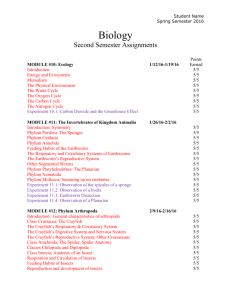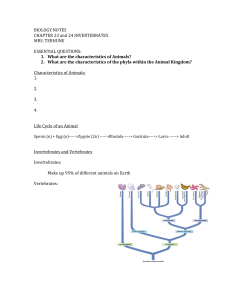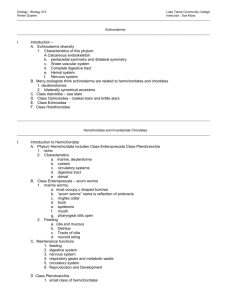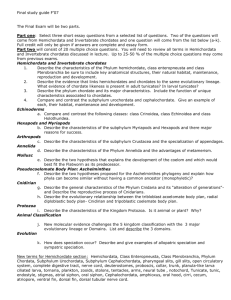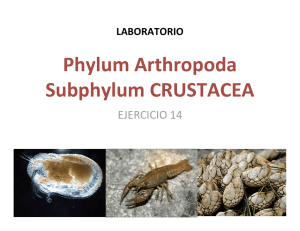PowerPoint 17: Arthropoda 1
advertisement
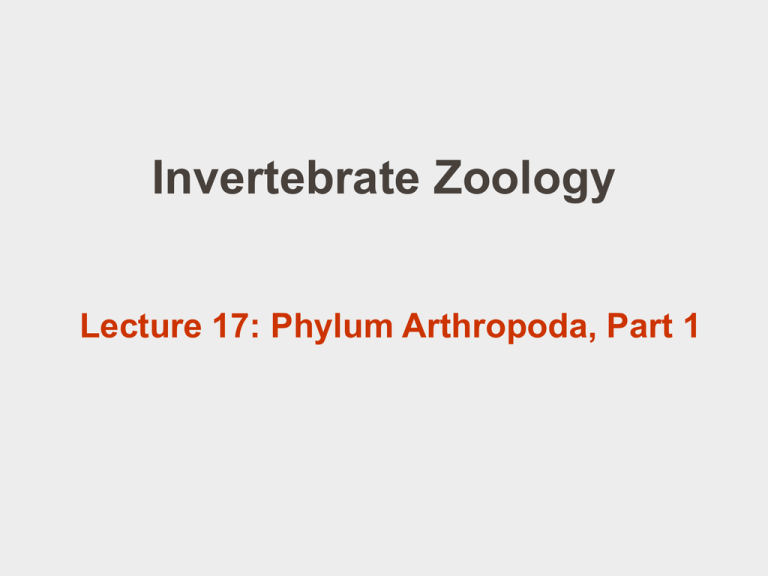
Invertebrate Zoology Lecture 17: Phylum Arthropoda, Part 1 Lecture outline Phylum Arthropoda Diversity/Classification Phylogeny Bauplan Basics Focus: Arthropod exoskeleton Feeding/digestion Circulation/gas exchange Osmoregulation/excretion Nervous system/sensory Reproduction Diversity/Classification Subphylum Trilobitomorpha Two longitudinal furrows divide body into three sections Marine; Paleozoic Extinct (end of Permian) Diversity/Classification Subphylum Crustacea: Lobsters, crabs, barnacles, copepods, etc… Antarctic krill Euphausia superba Subphylum Hexapoda: Insects Brusca & Brusca Dennis Kunkel Subphylum Myriapoda: Centipedes and Millipedes Subphylum Cheliceriformes Spiders, mites, horseshoe crabs, scorpions, sea spiders et al… Phylogeny Based on body plan & development Hypothesis 1: Bauplan basics Features shared with Phylum Annelida Classic protostome development Segmentation; segments added posteriorly Nervous system architecture Derived characters (differ from Annelida) Rigid cuticle: contains chitin; forms exoskeleton Open circulatory system; hemocoel Reduced coelom Key hypothesis: loss of functionality (i.e. peristalsis) Where are coelom “remnants” located? Intermediate phyla Why considered intermediate? Phylum Onychophora Phylum Tardigrada Bauplan basics Other features Tagmatization Paired jointed appendages “Primitive condition”: appendages associated with each segment, Lack motile cilia, except for some sperm Why? Which other group has non-motile cilia? Focus: cuticle Epidermis Secretes cuticle Dermal glands Variety of secretions Sensory structures Procuticle Chitin Calcium carbonate Crustacea Sclerotization Joints Epicuticle Cement layer Wax layer Molting Feeding/digestion Different modes of feeding Variety of mouthparts Complete digestive system Note digestive cecum Circulation/gas exchange Open circulatory system; ostiate heart Hemocoel: space bounded by basement membrane of epidermis Re-entry of hemolymph into heart? Circulation/gas exchange Respiration: Subphylum Crustacea Gills; body surface (small forms) Circulation/gas exchange Respiration: Hexapoda & Myriapoda Tracheal system (openings = spiracles) Circulation/gas exchange Respiration: Cheliceriformes book lungs; book gills Osmoregulation & ammonia excretion Crustacea: Gills (ammonia release only Antennal (green) gland Entry via hemocoel channels & active transport Selective secretion and uptake along tubule Osmoregulation & ammonia excretion Hexapoda, Myriapoda, Chelicerata: Malpighian tubules Closed distally: hemocoel Active ion transport fluid uptake Open into hindgut Adaptive value? Nervous system Organization Brain (=cerebral ganglia) Subesophogeal (subenteric) ganglion Ventral nerve cord (paired, fused partly or completely) Ganglia: one per segment or fewer (consolidated) Nervous system Crab: Note consolidated thoracic ganglia Sensory systems: Compound eye Compound eyes comprised of multiple ommatidia Interommatidial hairs in some… Sensory systems: Compound eye Key structures Cornea Crystalline cone/stalk Iris (=corneal pigment cells) Retinular cell w/rhabdome Sensory systems: Compound eye Light-adapted vs. dark-adapted eye Shift in pigment position (within iris) Alteration in light pathway Consequences for sensitivity and acuity Sensory systems: Compound eye Mosaic theory of insect vision Each ommatidium views piece of visual field Adaptive advantages of compound eye Acuity varies with Ommatidia concentration Size Flatness Key: angular distance Sensory systems: Sensillae Mechanosensory & chemosensory Reproduction: Overview Sexual reproduction Usually gonochoristic Some hermaphrodites Example: Barnacles Parthenogenesis in some groups Part of aphid life cycle Some crustaceans living in temporary ponds Egg production often food limited. Why? Example: Antarctic krill Reproduction: Male system Testes Vas deferens Seminal vesicle Accessory glands Types of secretions? Ejaculatory duct Gonopore Spermatophores (in some) Penis or modified appendages for copulation Damselfly penis Barnacle penis Spider pedipalps Reproduction: female system Ovaries Ovariole structure Egg batches Oviduct Accessory glands Types of secretions? Copulatory bursa Spermathecae Function? Bees and lobsters… Reproduction & molting Mate guarding Adaptive value for male? Adaptive value for female? Reproduction & cannibalism Hexapoda & Cheliceriformes (i.e. spiders) Adaptive value for male? Adaptive value for female?
